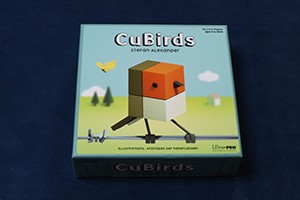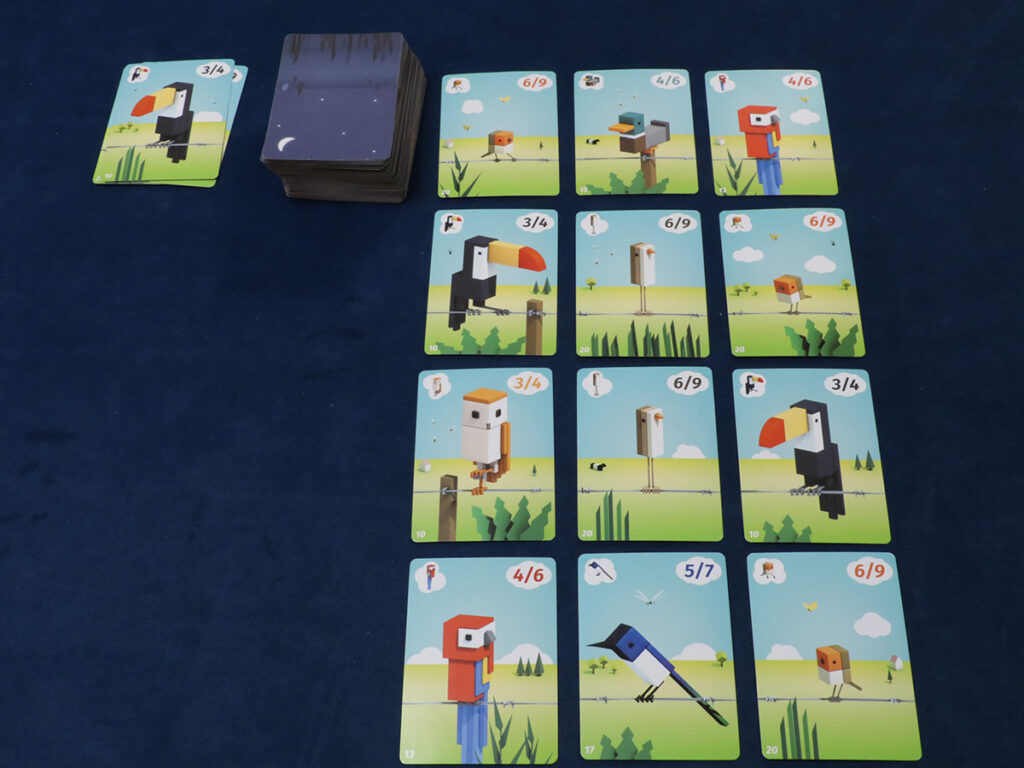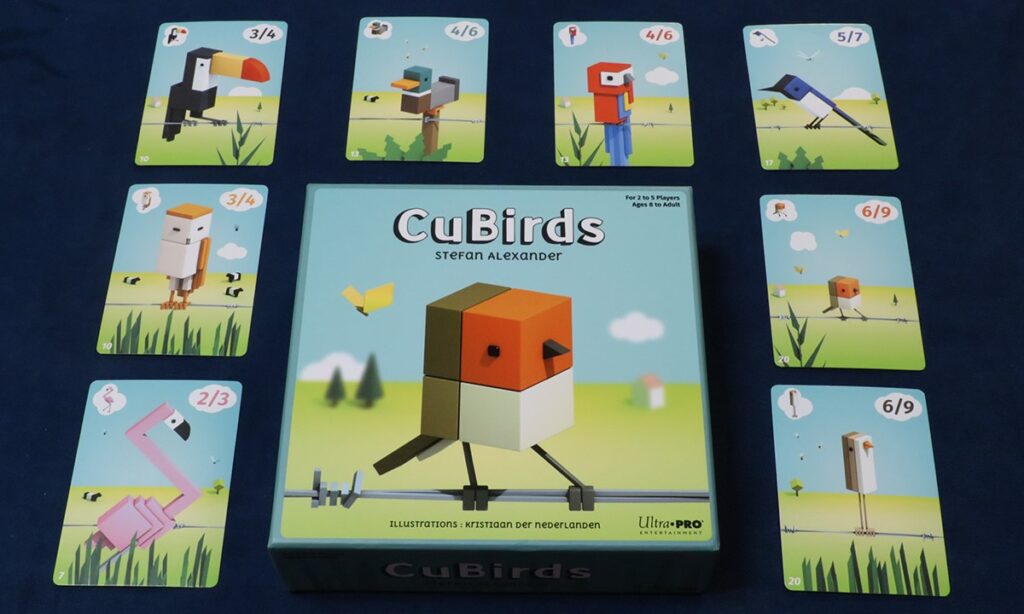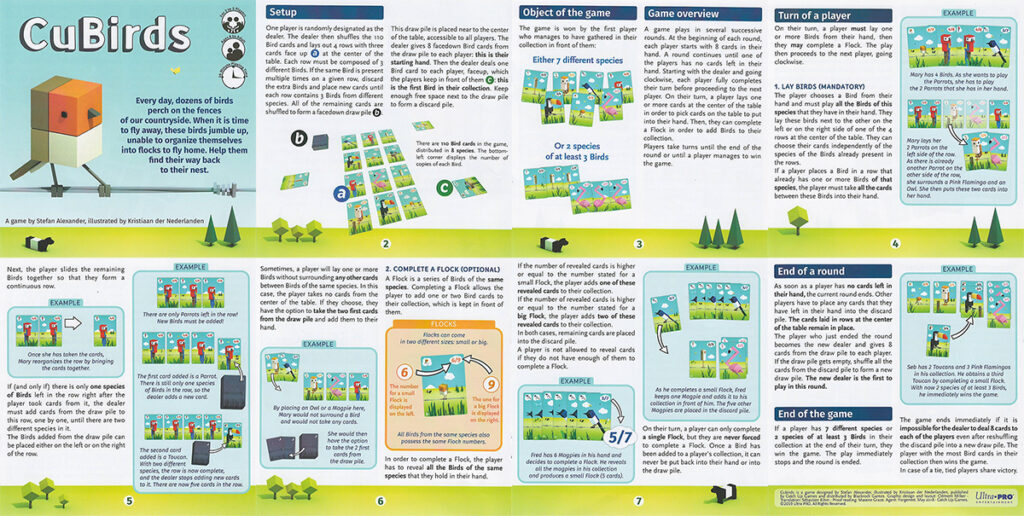
Board gaming during the pandemic was a very nontraditional experience for enthusiasts like the Assorted Meeples. With in-person gaming being out of the question, Board Game Arena became the primary way for us to experience our favorite games and make new discoveries. One such discovery that made its way to our shelves as things returned to normal was CuBirds.
I don’t know that it was any one factor that won us over here – the Minecraft-esque art for the birds is very distinct, the gameplay is easy to understand while being surprisingly deep, and many of us may have sworn the Reed Warblers and Robins to be our mortal nemeses during some late game night binges due to their seemingly omnipresent stints on the board.
All of that put together was clearly greater than the sum of its parts, so let’s dive into the rules so you can start experiencing this fun for yourself! Or you can check out a couple games we streamed in the video below!
How To Play CuBirds
Player Count: 2-5
Estimated Play Time: 20 minutes
CuBirds Rules PDF
Victory in CuBirds is achieved one of two ways. You either need to collect 7 unique bird species, or 3 copies of 2 unique bird species, as detailed in page 3 of the rules image below.
There are 8 different species of birds that can appear during a CuBirds game, and they are as follows:
- Flamingo: 2 required for a small flock, 3 for a large flock, 7 cards in the deck
- Owl: 3 required for a small flock, 4 for a large flock, 10 cards in the deck
- Toucan: 3 required for a small flock, 4 for a large flock, 10 cards in the deck
- Duck: 4 required for a small flock, 6 for a large flock, 13 cards in the deck
- Parrot: 4 required for a small flock, 6 for a large flock, 13 cards in the deck
- Magpie: 5 required for a small flock, 7 for a large flock, 17 cards in the deck
- Robin: 6 required for a small flock, 9 for a large flock, 20 cards in the deck
- Reed Warbler: 6 required for a small flock, 9 for a large flock, 20 cards in the deck

Small and large flock numbers are also displayed on each card in the upper right hand corner, and the number of cards each species has in the deck is also written in the lower left corner of every card.
Now that you know how to read the bird cards, let’s start getting set up!
Setup
The dealer shuffles the 110 card deck, then makes 4 rows containing 3 birds each in the center of the table. No row may have a duplicate species, so if a duplicate shows up, discard it and replace the card with a bird unique to the row.

After your rows are set up, the dealer deals a hand of 8 cards face down to each player. Then they deal 1 bird face up to each player – this is the first bird in each player’s bird collection. Choose who goes first (we typically roll a die), and then the game begins!
Gameplay
A turn in CuBirds proceeds as follows:
Lay Birds
This mandatory action requires you to choose a species of bird in your hand, then place all copies of that species from your hand on either the left or right end of a row. It doesn’t matter what birds are already in the row when choosing which ones to play from your hand, nor does it matter how many – rows have no maximum limit.
If the row you placed birds in already has birds of the species you played from your hand, you collect all birds between the ones you played and the ones in the row and add them to your hand. After that, slide any remaining birds in the row over until there is no longer a gap between cards.
Then if only one species of bird remains in the row, cards are added to the end of that row from the deck until 2 species are present again.



So what would have happened if I had played a bird species from my hand that did not have any cards between a bird of the same species, such as if I had played my Toucans on the right side of the row or played a brand new bird to the row like a Robin?
Since I would not have picked up any cards from such an action, I may choose to draw 2 cards.
That choice might seem like a no-brainer if you’re a card game veteran, but it’s actually an extremely important one, as we’ll get into in the strategy section.
Complete A Flock
This is an optional step taken at the end of your turn. If you have enough of the same type of bird in your hand to complete a small or large flock, you may reveal all copies of that species in your hand now.
Should you have enough to meet or exceed the requirements for a small flock, add one of your revealed birds to your collection. For a large flock, add 2 to your collection. You then discard the rest of the birds you revealed.
You may only complete up to 1 flock per turn.
Going back to the Toucans pictured above, let’s say my opponent played a Flamingo at the right end of the row with the 4 Toucans in it and added those 4 cards to their hand.
They now have more than enough for a large flock, as they already had one in their hand, so they reveal all 5 Toucans in their hand, add 2 to their collection, then discard the remaining 3.
Ending A Round
If a player winds up with 0 cards in their hand as a result of either of the previous turn steps, the round ends. All players then discard their hands, and 8 new cards are dealt to each player. Cards in the 4 rows remain where they are, as do birds in each player’s collection.
The player who ended the round takes another turn after the cards are dealt. If you run out of cards in the deck, shuffle all cards in the discard pile to form a new deck.
Winning The Game
A player wins at CuBirds as soon as they have 7 unique species of bird in their collection (like a Flamingo, Owl, Toucan, Duck, Parrot, Reed Warbler, and Robin), or if they have 3 birds each from 2 unique species in their collection (like 3 Robins and 3 Toucans).

If a game somehow reaches the point where the dealer cannot deal 8 cards to each player after a round ends, the game will also end at this point, and the player with the most birds in their collection is declared the winner. Should multiple players tie for this victory condition, they share the victory.
I’ve never seen the latter happen; you’ll have to let us know on social media if you’ve ever had a game reach this conclusion!
CuBirds Strategy Guide
Now that we’ve covered how to read your cards, how to play, and the conditions for victory, it’s time to focus on how to win! While no strategy presented here will guarantee you a victory (this is a card game, so luck will be a factor), there are lots of things you can do to improve your odds of coming out as the top bird collector!
Pay Attention To Which Birds You Need
Obvious strategy is obvious, but this advice goes beyond simply looking at the birds you’ve collected. You also need to pay attention to the birds that are in the 4 rows everyone is vying for and plan your move accordingly to acquire the ones you’re missing for victory.
This is also a good opportunity to point out that you don’t have to declare which victory condition you’re going for at any point, and are free to change up your strategy as the situation warrants.
For example, you might have gotten 3 early Reed Warblers, but be forced to change tactics to collecting 6 other bird species since hands aren’t lasting enough to complete large flocks or because players are consistently grabbing small numbers of birds to keep rows small.
The more ways you have to win, the harder it becomes for the table to block you too. Just don’t wait too long to shift plans, or you may find an opponent is going to beat you to the punch.
Pay Attention To Which Birds Your Opponents Need
This is as important in CuBirds as minding your own strategy, particularly as more turns and rounds get completed. The very last thing you want to do is set out several Magpies to claim the Owl you need only for the next player to scoop them up and complete a flock of their 7th unique bird species.
We as a table have actually managed to stave off an impending loss from a player who got ahead of us for several turns, nearly upsetting their victory in the process, simply by paying attention and working together. It doesn’t always work out that way, of course, but your actions can have a pretty big impact when timed correctly.
Set Yourself Up For Success With Extra Turns
Extra turns tend to win games when they are an option. Whether you’re defending the Yawning Portal in Lords of Waterdeep or Time Walking your opponents with the Time Travelers in Smash Up (a reference to a Magic: The Gathering card that also lets you take an extra turn), this effect is extremely powerful, and the same holds true in CuBirds.
The moment a player runs out of cards, either when laying birds or completing a flock, everyone else has to discard their hand, then everyone receives a new hand of 8 cards. After that, the player who ran out of cards takes another turn.
You can take advantage of this mechanic three different ways. First, and most obviously, is to just use the extra turn as a value turn. You’re getting to look at a brand new hand of cards, after all, so you might as well see if you can complete an extra flock or prepare for an explosive move next turn.
Second, you can use your last cards to plan a bigger move with the new cards you draw. This is a little risky, as there’s no guarantee you’ll draw the cards you need, but if you were able to add 3 Reed Warblers to 2 in a row with a Robin on the end, odds are pretty good you’ll draw a Robin and a Reed Warbler to help you complete a small flock due to how many of each are in the deck.
Finally, you can use your extra turn to disrupt your opponents’ plans. If someone’s been gathering birds for 3 or 4 turns without completing a flock, it’s probably a good idea to force them to change the cards they’re holding before they can snag 2 birds from a large flock.
Monitor How Many Birds Are Left In The Deck
This strategy is most important on a species by species basis, as you and your opponents will need to collect multiple copies of a bird species to complete a flock.
Some birds, like the Flamingo, quickly become nearly impossible to flock, as there simply aren’t that many of them to begin with (7 out of 110 cards, if you’ll recall). Removing 1 or 2 from the game because they were flocked by other players means your odds of collecting the 2 you need are not especially good, as flocked cards will never return to the deck.
Fortunately, it’s easy to track how many copies of each bird are in a full deck, as that information is in the lower left corner of every card, so subtracting the ones that have been flocked to figure out how many are left is public knowledge anyone can (and should!) use.
Keeping a tally of the cards in the deck isn’t a bad idea either, as you can calculate your odds of drawing a specific bird when planning an extra turn or deciding whether to draw extra cards from the deck.
Here’s the math you’ll need to calculate this information (complete equations in the parenthesis before multiplying where applicable):
110 – the number of birds in all players’ collections
The total deck size
(The total deck size / the number of a species of a bird remaining in the deck) * 100
Your percentage odds of drawing a specific bird from a newly reformed deck
(The current deck size / the number of a species of bird remaining in the deck) * 100
Your percentage odds of drawing a specific bird from the cards left in the current deck
One thing to note for the last equation – your information will almost certainly be imperfect, as your opponents will have cards you don’t know about in their hands.
You may have to make an educated guess or two to establish your chances here, but if you pick a couple likely numbers for the number of cards you need in the deck, you can get a reasonable estimate for your drawing odds.
Know When To Draw And When Not To
CuBirds is the first game I’ve seen in a while where drawing extra cards isn’t automatically the right thing to do when the choice arises. Sure there’s no other option when someone empties their hand and force feeds you a new hand, but you’ll often be the one trying to do that in this game, meaning that drawing cards works against that goal!
Typically, the only time I elect to draw cards (which is only an option if you don’t pick up a bird from the middle when laying birds) is if I’m close to completing a flock and need one more bird to do so.
The odds of getting the right bird are generally poor, so even then, I’ll only do this if I already have a large hand and know I can’t trigger a new round or if I know an opponent is about to empty their hand and trigger a new round before I’ll get another turn.
Cubirds Review – Is It A Good Game?
CuBirds hits one of my favorite board game niches perfectly – easy to understand, difficult to master. While the earlier strategy section shows how much there is for a skilled player to keep track of, it only takes a turn or two of gameplay before new players are having as much fun as the veterans with the nuances of gameplay.

CuBirds also has the distinction of being a family friendly game – as long as I’m not cursing out the “straws” (Reed Warblers) or the “blue jays” (Magpies) while they’re cluttering up the board. There’s nothing objectionable I can see about the art or gameplay in any way, making it a great entry point for kids dipping their toes into strategy games.
Dedicated board game groups will also get a lot of mileage out of this game, as it’s light enough for warming up or winding down without sacrificing the impact of skill and strategic moves. Sure, CuBirds is not going to be the meat and potatoes of a board game night, but I’d argue that it isn’t supposed to be.
Plus, it’s less than 20 bucks at time of publication, which is a great price point for the fun you’ll get out of it. Or you can try before you buy on Board Game Arena!
Other Board Game Articles You’ll Love:
- Lords of Waterdeep Lords Strategy
- Smash Up Expansions Ranked
- Cindr Board Game Rules
- Take 5 Rules and Strategies
- Blokus Rules and Variants
- Quinto Board Game Rules
Braden is a founder of Assorted Meeples and has been a gamer & writer with a vivid imagination all his life. Don’t believe us? Check out his excitement when meeting Goosebumps author R.L. Stine as a kid! An avid Magic: The Gathering spellslinger for over 15 years, you can always convince him to shuffle up for a game (or three!) of Commander.

